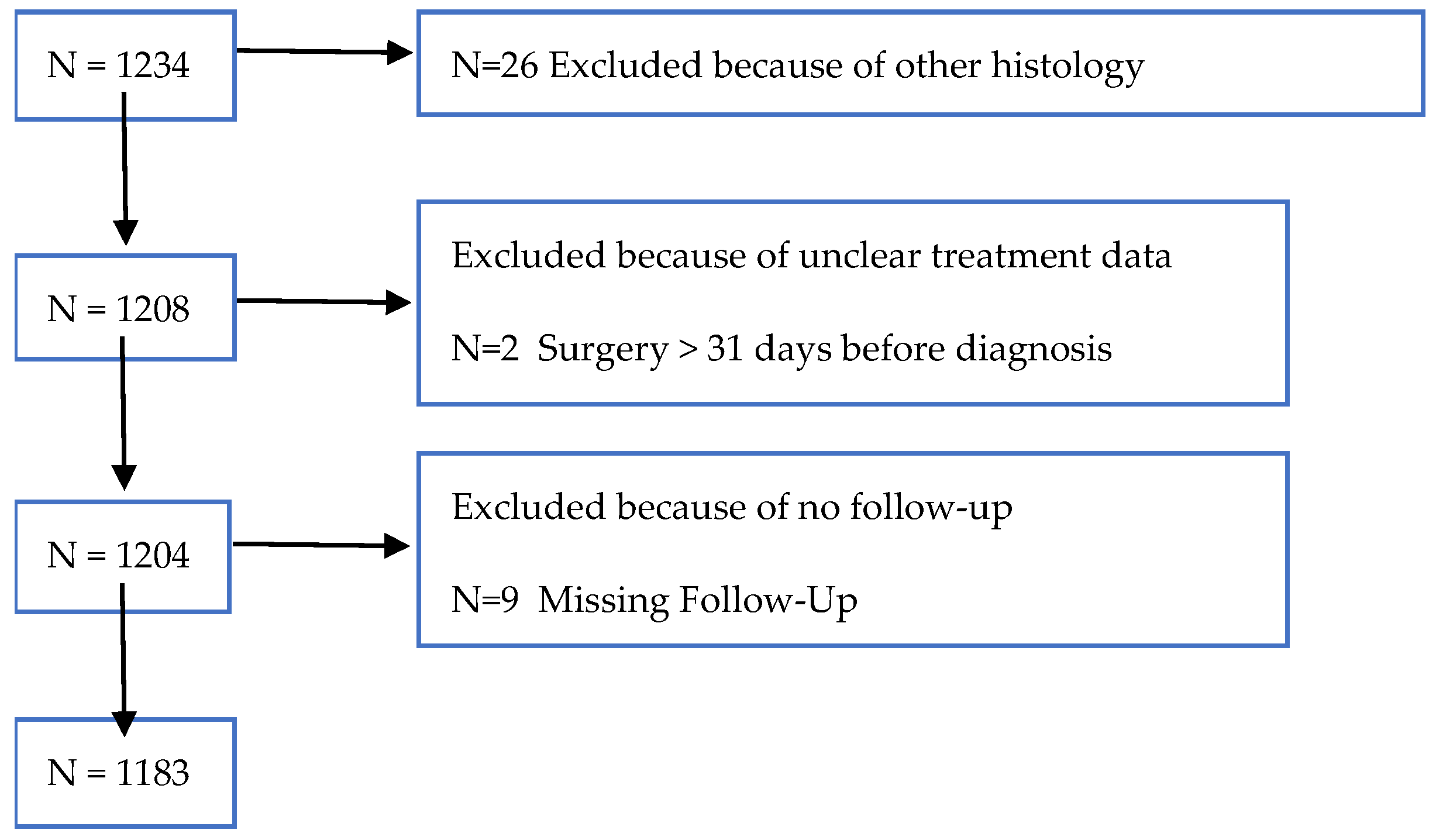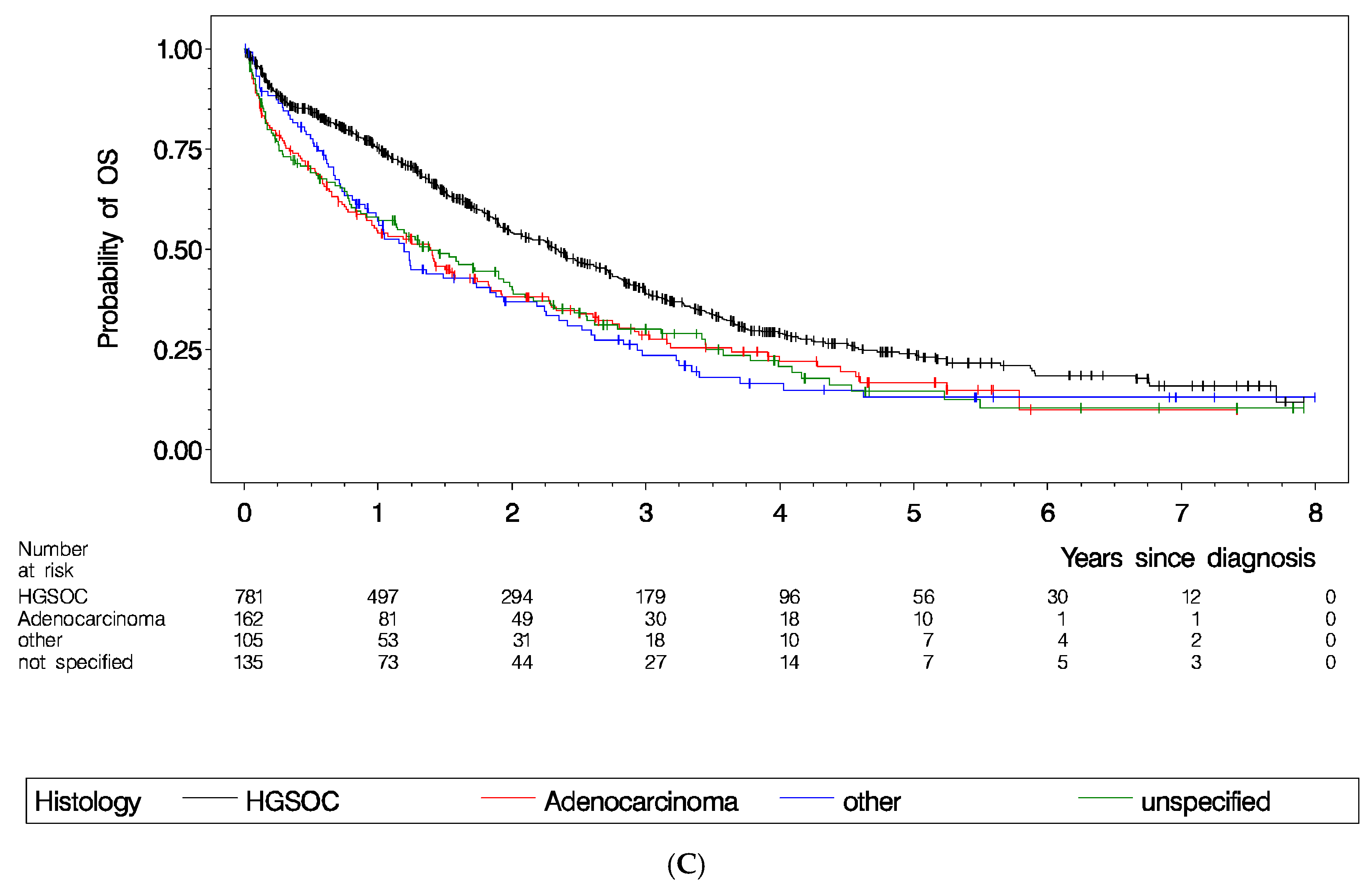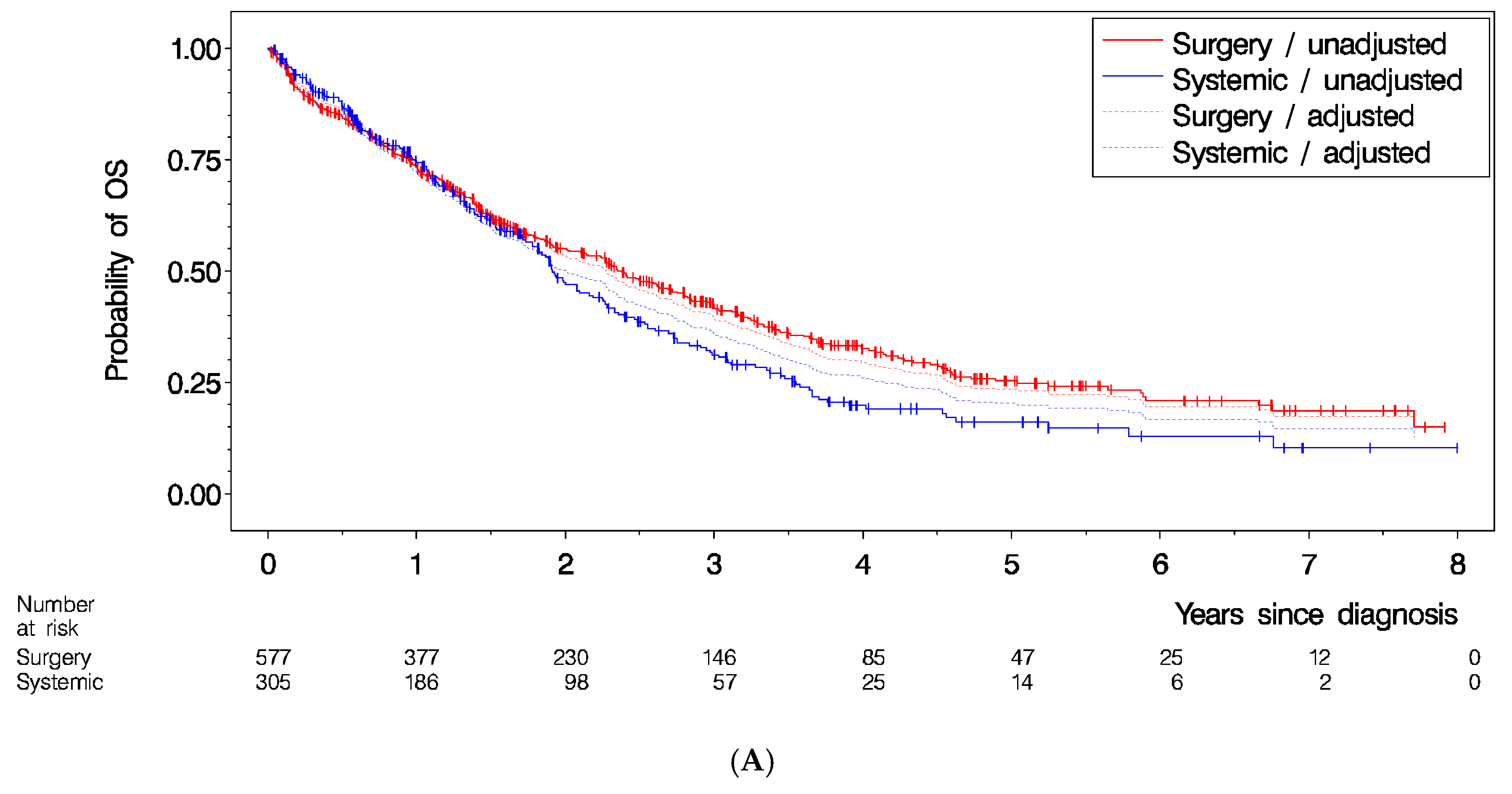Characteristics, Treatment Patterns and Survival of International Federation of Gynecology and Obstetrics Stage IV Epithelial Ovarian Cancer—A Population-Based Study
Abstract
:Simple Summary
Abstract
1. Introduction
2. Methods
3. Results
Survival Analysis
4. Discussion
5. Conclusions
Author Contributions
Funding
Institutional Review Board Statement
Informed Consent Statement
Data Availability Statement
Conflicts of Interest
References
- Buttmann-Schweiger, N.; Kraywinkel, K. Epidemiologie von Eierstockkrebs in Deutschland. Onkologe 2019, 25, 92–98. [Google Scholar] [CrossRef]
- Ataseven, B.; Chiva, L.M.; Harter, P.; Gonzalez-Martin, A.; du Bois, A. FIGO stage IV epithelial ovarian, fallopian tube and peritoneal cancer revisited. Gynecol. Oncol. 2016, 142, 597–607. [Google Scholar] [CrossRef] [PubMed]
- Chang, S.-J.; Hodeib, M.; Chang, J.; Bristow, R.E. Survival impact of complete cytoreduction to no gross residual disease for advanced-stage ovarian cancer: A meta-analysis. Gynecol. Oncol. 2013, 130, 493–498. [Google Scholar] [CrossRef] [PubMed]
- Bristow, R.E.; Tomacruz, R.S.; Armstrong, D.K.; Trimble, E.L.; Montz, F.J. Survival effect of maximal cytoreductive surgery for advanced ovarian carcinoma during the platinum era: A meta-analysis. J. Clin. Oncol. Off. J. Am. Soc. Clin. Oncol. 2002, 20, 1248–1259. [Google Scholar] [CrossRef] [PubMed]
- Gadducci, A.; Cosio, S.; Zizioli, V.; Notaro, S.; Tana, R.; Panattoni, A.; Sartori, E. Patterns of Recurrence and Clinical Outcome of Patients With Stage IIIC to Stage IV Epithelial Ovarian Cancer in Complete Response After Primary Debulking Surgery Plus Chemotherapy or Neoadjuvant Chemotherapy Followed by Interval Debulking Surgery: An Italian Multicenter Retrospective Study. Int. J. Gynecol. Cancer Off. J. Int. Gynecol. Cancer Soc. 2017, 27, 28–36. [Google Scholar]
- Ren, Y.; Jiang, R.; Yin, S.; You, C.; Liu, D.; Cheng, X.; Tang, J.; Zang, R. Radical surgery versus standard surgery for primary cytoreduction of bulky stage IIIC and IV ovarian cancer: An observational study. BMC Cancer 2015, 15, 583. [Google Scholar] [CrossRef]
- Jamieson, A.; Sykes, P.; Eva, L.; Bergzoll, C.; Simcock, B. Subtypes of stage IV ovarian cancer; response to treatment and patterns of disease recurrence. Gynecol. Oncol. 2017, 146, 273–278. [Google Scholar] [CrossRef]
- Chi, D.S.; Zivanovic, O.; Levinson, K.L.; Kolev, V.; Huh, J.; Dottino, J.; Gardner, G.J.; Leitao, M.M., Jr.; Levine, D.A.; Sonoda, Y.; et al. The incidence of major complications after the performance of extensive upper abdominal surgical procedures during primary cytoreduction of advanced ovarian, tubal, and peritoneal carcinomas. Gynecol. Oncol. 2010, 119, 38–42. [Google Scholar] [CrossRef]
- Rafii, A.; Stoeckle, E.; Jean-Laurent, M.; Ferron, G.; Morice, P.; Houvenaeghel, G.; Lecuru, F.; Leblanc, E.; Querleu, D. Multi-center evaluation of post-operative morbidity and mortality after optimal cytoreductive surgery for advanced ovarian cancer. PLoS ONE 2012, 7, e39415. [Google Scholar] [CrossRef]
- Zimmermann, J.S.M.; Ramisch, P.; Radosa, M.P.; Radosa, C.G.; Kaya, A.C.; Brucker, S.Y.; Taran, F.A.; Ulrich, U.A.; Hackethal, A.; Deeken, M.; et al. Laparoscopic Fertility-Sparing Surgery for Early Ovarian Malignancies. Cancers 2023, 15, 5099. [Google Scholar] [CrossRef]
- Machida, H.; Tokunaga, H.; Matsuo, K.; Matsumura, N.; Kobayashi, Y.; Tabata, T.; Kaneuchi, M.; Nagase, S.; Mikami, M. Survival outcome and perioperative complication related to neoadjuvant chemotherapy with carboplatin and paclitaxel for advanced ovarian cancer: A systematic review and meta-analysis. Eur. J. Surg. Oncol. 2020, 46, 868–875. [Google Scholar] [CrossRef] [PubMed]
- Ghirardi, V.; Moruzzi, M.C.; Bizzarri, N.; Vargiu, V.; D’Indinosante, M.; Garganese, G.; Pasciuto, T.; Loverro, M.; Scambia, G.; Fagotti, A. Minimal residual disease at primary debulking surgery versus complete tumor resection at interval debulking surgery in advanced epithelial ovarian cancer: A survival analysis. Gynecol. Oncol. 2020, 157, 209–213. [Google Scholar] [CrossRef] [PubMed]
- Onda, T.; Satoh, T.; Saito, T.; Kasamatsu, T.; Nakanishi, T.; Nakamura, K.; Wakabayashi, M.; Takehara, K.; Saito, M.; Ushijima, K.; et al. Comparison of treatment invasiveness between upfront debulking surgery versus interval debulking surgery following neoadjuvant chemotherapy for stage III/IV ovarian, tubal, and peritoneal cancers in a phase III randomised trial: Japan Clinical Oncology Group Study JCOG0602. Eur. J. Cancer 2016, 64, 22–31. [Google Scholar] [PubMed]
- Vergote, I.; Tropé, C.G.; Amant, F.; Kristensen, G.B.; Ehlen, T.; Johnson, N.; Verheijen, R.H.; Van Der Burg, M.E.; Lacave, A.J.; Panici, P.B.; et al. Neoadjuvant chemotherapy or primary surgery in stage IIIC or IV ovarian cancer. N. Engl. J. Med. 2010, 363, 943–953. [Google Scholar] [CrossRef]
- Rauh-Hain, J.A.; Melamed, A.; Wright, A.; Gockley, A.; Clemmer, J.T.; Schorge, J.O.; Del Carmen, M.G.; Keating, N.L. Overall Survival Following Neoadjuvant Chemotherapy vs Primary Cytoreductive Surgery in Women With Epithelial Ovarian Cancer: Analysis of the National Cancer Database. JAMA Oncol. 2017, 3, 76–82. [Google Scholar] [CrossRef]
- Melamed, A.; Rauh-Hain, J.A.; Gockley, A.A.; Nitecki, R.; Ramirez, P.T.; Hershman, D.L.; Keating, N.; Wright, J.D. Association Between Overall Survival and the Tendency for Cancer Programs to Administer Neoadjuvant Chemotherapy for Patients With Advanced Ovarian Cancer. JAMA Oncol. 2021, 7, 1782–1790. [Google Scholar] [CrossRef]
- Gill, S.E.; McGree, M.E.; Weaver, A.L.; Cliby, W.A.; Langstraat, C.L. Optimizing the treatment of ovarian cancer: Neoadjuvant chemotherapy and interval debulking versus primary debulking surgery for epithelial ovarian cancers likely to have suboptimal resection. Gynecol. Oncol. 2017, 144, 266–273. [Google Scholar] [CrossRef] [PubMed]
- Rauh-Hain, J.A.; Rodriguez, N.; Growdon, W.B.; Goodman, A.K.; Boruta, D.M.; Horowitz, N.S.; del Carmen, M.G.; Schorge, J.O. Primary debulking surgery versus neoadjuvant chemotherapy in stage IV ovarian cancer. Ann. Surg. Oncol. 2012, 19, 959–965. [Google Scholar] [CrossRef]
- Bristow, R.E.; Montz, F.J.; Lagasse, L.D.; Leuchter, R.S.; Karlan, B.Y. Survival Impact of Surgical Cytoreduction in Stage IV Epithelial Ovarian Cancer. Gynecol. Oncol. 1999, 72, 278–287. [Google Scholar] [CrossRef]
- Sørensen, S.M.; Høgdall, C.; Mosgaard, B.J.; Dalgaard, M.I.R.; Jensen, M.P.; Fuglsang, K.; Schnack, T.H. Residual tumor and primary debulking surgery vs interval debulking surgery in stage IV epithelial ovarian cancer. Acta Obstet. Gynecol. Scand. 2022, 101, 334–343. [Google Scholar] [CrossRef]
- Kahn, R.M.; McMinn, E.; Yeoshoua, E.; Boerner, T.; Zhou, Q.; Iasonos, A.; Roche, K.L.; Zivanovic, O.; Gardner, G.J.; Sonoda, Y.; et al. Intrathoracic surgery as part of primary cytoreduction for advanced ovarian cancer: Going to the next level—A Memorial Sloan Kettering Cancer Center study. Gynecol. Oncol. 2023, 170, 46–53. [Google Scholar] [CrossRef] [PubMed]
- Drouin, L.; Guani, B.; Balaya, V.; Azaïs, H.; Betrian, S.; Bolze, P.-A.; Dabi, Y.; Kerbage, Y.; Sanson, C.; Zaccarini, F.; et al. Results of a 2021 French National Survey on Management of Patients with Advanced Stage Epithelial Ovarian Cancer. J. Clin. Med. 2021, 10, 4829. [Google Scholar] [CrossRef] [PubMed]
- Fläche und Bevölkerung|Statistikportal.de. Statistische Ämter des Bundes und der Länder|Gemeinsames Statistikportal. Available online: http://www.statistikportal.de/de/bevoelkerung/flaeche-und-bevoelkerung (accessed on 7 July 2023).
- Landesrecht BW KrebsRVO|Landesnorm Baden-Württemberg|Gesamtausgabe|Verordnung des Sozialministeriums zur Regelung der Krebsregistrierung in Baden-Württemberg (Krebsregisterverordnung—KrebsRVO) Vom 12. Dezember 2017|Gültig ab: 30 December 2017. Available online: https://www.landesrecht-bw.de/jportal/;jsessionid=C8120818F2D461C88769ECC95FBCB88C.jp91?quelle=jlink&query=KrebsRegV+BW&psml=bsbawueprod.psml&max=true&aiz=true#jlr-KrebsRegVBW2017rahmen (accessed on 7 July 2023).
- DIMDI—ICD-O-3 Erste Revision. Available online: https://www.dimdi.de/static/de/klassifikationen/icd/icd-o-3/icdo3rev1html/chapter-m.htm (accessed on 7 July 2023).
- Dabi, Y.; Francogyn, F.T.G.d.R.; Huchon, C.; Ouldamer, L.; Bendifallah, S.; Collinet, P.; Bricou, A.; Daraï, E.; Ballester, M.; Lavoue, V.; et al. Patients with stage IV epithelial ovarian cancer: Understanding the determinants of survival. J. Transl. Med. 2020, 18, 134. [Google Scholar] [CrossRef]
- Ataseven, B.; Grimm, C.; Harter, P.; Heitz, F.; Traut, A.; Prader, S.; du Bois, A. Prognostic impact of debulking surgery and residual tumor in patients with epithelial ovarian cancer FIGO stage IV. Gynecol. Oncol. 2016, 140, 215–220. [Google Scholar] [CrossRef] [PubMed]
- Colombo, N.; Sessa, C.; du Bois, A.; Ledermann, J.; McCluggage, W.G.; McNeish, I.; Morice, P.; Pignata, S.; Ray-Coquard, I.; Vergote, I.; et al. ESMO-ESGO consensus conference recommendations on ovarian cancer: Pathology and molecular biology, early and advanced stages, borderline tumours and recurrent disease. Ann. Oncol. 2019, 30, 672–705. [Google Scholar] [CrossRef] [PubMed]
- Shalowitz, D.I.; Epstein, A.J.; Ko, E.M.; Giuntoli, R.L. Non-surgical management of ovarian cancer: Prevalence and implications. Gynecol. Oncol. 2016, 142, 30–37. [Google Scholar] [CrossRef] [PubMed]
- Zijlstra, M.; Timmermans, M.; Fransen, H.; Van Der Aa, M.; Reyners, A.; Raijmakers, N.; Van De Poll-franse, L. Treatment patterns and associated factors in patients with advanced epithelial ovarian cancer: A population-based study. Int. J. Gynecol. Cancer 2019, 29, 1032–1037. [Google Scholar] [CrossRef] [PubMed]
- van Altena, A.M.; Karim-Kos, H.E.; de Vries, E.; Kruitwagen, R.F.; Massuger, L.F.; Kiemeney, L.A. Trends in therapy and survival of advanced stage epithelial ovarian cancer patients in the Netherlands. Gynecol. Oncol. 2012, 125, 649–654. [Google Scholar] [CrossRef]
- Dahm-Kähler, P.; Holmberg, E.; Holtenman, M.; Rådestad, A.F.; Borgfeldt, C.; Hjerpe, E.; Marcickiewicz, J.; Bjurberg, M.; Tholander, B.; Hellman, K.; et al. Implementation of National Guidelines increased survival in advanced ovarian cancer—A population-based nationwide SweGCG study. Gynecol. Oncol. 2021, 161, 244–250. [Google Scholar] [CrossRef]
- van Walree, I.C.; Bretveld, R.; van Huis-Tanja, L.H.; Louwers, J.A.; Emmelot-Vonk, M.H.; Hamaker, M.E. Reasons for guideline non-adherence in older and younger women with advanced stage ovarian cancer. Gynecol. Oncol. 2020, 157, 593–598. [Google Scholar] [CrossRef]





| N = 1183 | |
|---|---|
| Age | |
| ≤50 | 102 (8.6%) |
| 51–65 | 379 (32.0%) |
| 66–80 | 522 (44.1%) |
| >80 | 180 (15.2%) |
| Performance status | |
| ECOG | n = 276 |
| 0 | 119 (43.1%) |
| 1 | 102 (37.0%) |
| 2 | 28 (10.1%) |
| 3 | 20 (7.3%) |
| 4 | 7 (2.5%) |
| Unknown | n = 907 |
| Histology | N = 1183 |
| HGSOC | 781 (66.0%) |
| Adenocarcinoma | 162 (13.7%) |
| Other | 105 (8.9%) |
| Unspecified | 135 (11.4%) |
| Metastasis localization | |
| Known | n = 954 |
| Unknown | n = 229 |
| Pleura | 309 (32.4%) |
| Lymph nodes | 225 (26.7%) |
| Liver | 278 (29.1%) |
| Lung | 104 (10.9%) |
| Other | 231 (24.21%) |
| Brain | 10 (1.1%) |
| Generalized | 6 (0.6%) |
| Peritoneum | 95 (10.0%) |
| Skin | 16 (1.7%) |
| Adrenal gland | 10 (1.1%) |
| Bone | 42 (4.4%) |
| Bone marrow | 1 (0.1%) |
| N = 1183 | |
|---|---|
| Treatment received | |
| None | 221 (18.7%) |
| Surgery only | 145 (12.3%) |
| Systemic only | 279 (23.6%) |
| Radiation only | 5 (0.4%) |
| Surgery + systemic | 473 (40.0%) |
| Surgery + radiation | 1 (0.1%) |
| Surgery + radiation + systemic | 50 (4.23%) |
| Systemic + radiation | 9 (0.8%) |
| Received surgery | 669 (56.6%) |
| Received systemic | 811 (68.6%) |
| Received radiation | 65 (5.5%) |
| Intention of first surgery | (n = 669) |
| Diagnostic | 48 (12.0%) |
| Curative | 220 (55.0%) |
| Palliative | 113 (28.3%) |
| Revision | 3 (0.8%) |
| Other | 16 (4.0%) |
| Unknown | 269 |
| Residual status after first surgery | (n = 669) |
| R0 | 157 (37.1%) |
| R1 | 118 (27.9%) |
| R2 | 148 (35.0%) |
| RX/Unknown | 246 |
| Sequence of surgery and systemic therapy, disregarding radiation therapy | n = 1183 |
| No surgery, no systemic | 226 (19.1%) |
| Surgery only | 146 (12.3%) |
| Surgery followed by systemic | 452 (38.2%) |
| Systemic only | 288 (24.3%) |
| Systemic followed by surgery | 71 (6.0%) |
| Primary treatment within 2 months post-diagnosis | n = 1183 |
| No surgery, no systemic | 226 (19.1%) |
| Surgery | 577 (48.8%) |
| Systemic | 305 (25.8%) |
| Surgery/systemic later | 75 (6.3%) |
| Treatment scheme * | n = 1183 |
| Surgery only | 119 (10.0%) |
| Surgery followed by systemic | 376 (31.8%) |
| Systemic | 267 (22.6%) |
| Systemic only | 201 |
| Systemic followed by surgery | 66 |
| other | 421 (35.6%) |
| No Surgery/No Systemic Treatment | Surgery Only | Surgery Followed by Systemic | Systemic Treatment Only | Systemic Followed by Surgery | |
|---|---|---|---|---|---|
| N = 226 | N = 146 | N = 452 | N = 288 | N = 71 | |
| Age (N = 1183) | |||||
| ≤50 (N = 102) | 15 (14.7%) | 8 (7.8%) | 48 (47.1%) | 23 (22.6%) | 8 (11.3%) |
| 51–65 (N = 379) | 48 (12.7%) | 37 (9.8%) | 183 (48.3%) | 86 (22.7%) | 25 (6.6%) |
| 66–80 (N = 522) | 94 (18.0) | 65 (12.5%) | 192 (36.8%) | 135 (25.9%) | 36 (6.9%) |
| >80 (N = 180) | 69 (38.3%) | 36 (20.0%) | 29 (16.1%) | 44 (24.4%) | 2 (1.1%) |
| ECOG (N = 276) | |||||
| 0 (N = 119) | 11 (9.2%) | 19 (16.0%) | 67 (56.3%) | 18 (15.1%) | 4 (3.4%) |
| 1 (N = 102) | 11 (10.8%) | 17 (16.7%) | 42 (41.2%) | 26 (25.5%) | 6 (5.9%) |
| 2 (N = 28) | 9 (32.1%) | 4 (14.3%) | 8 (28.6%) | 7 (25.0%) | 0 |
| 3 (N = 20) | 6 (30.0%) | 6 (30.0%) | 5 (25.0%) | 3 (15.0%) | 0 |
| 4 (N = 7) | 5 (71.4%) | 1 (14.3%) | 0 | 1 (14.3%) | 0 |
| Unknown (N = 907) | 184 | 99 | 330 | 233 | 61 |
| Histology (N = 1183) | |||||
| HGSOC (N = 781) | 111 (14.2%) | 108 (13.8%) | 340 (42.5%) | 164 (21.0%) | 58 (7.4%) |
| Adenocarcinoma (N = 162) | 44 (27.2%) | 13 (8.0%) | 54 (33.3%) | 44 (27.2%) | 7 (4.3%) |
| Other (N = 105) | 18 (17.1%) | 16 (15.2%) | 39 (37.1%) | 29 (27.6%) | 3 (2.9%) |
| Unspecified (N = 135) | 53 (39.3%) | 9 (6.7%) | 19 (14.1%) | 51 (37.8%) | 3 (2.2%) |
| Metastasis localization (N = 954) | |||||
| Pleura (N = 309) | 52 (16.8%) | 39 (12.6%) | 118 (38.2%) | 75 (24.3%) | 25 (8.1%) |
| Lymph nodes (N = 255) | 43 (16.9%) | 20 (7.8%) | 106 (41.6%) | 72 (28.2%) | 14 (5.5%) |
| Hepatic (N = 278) | 58 (20.9%) | 23 (8.3%) | 97 (34.9%) | 89 (32.0%) | 11 (4.0%) |
| Lung (N = 104) | 29 (27.9%) | 14 (13.5%) | 23 (22.1%) | 33 (31.7%) | 5 (4.8%) |
| Others (N = 369) | 72 (19.5%) | 57 (15.5%) | 137(37.1%) | 87 (23.66%) | 16 (4.3%) |
| Unknown (N = 229) | 42 | 33 | 88 | 50 | 16 |
| (A) Age and histology. | ||||||
| Hazard Ratio | 95%-Confidence Interval | p-Value | ||||
| Age | <0.0001 | |||||
| ≤50 | 1.00 | - | ||||
| 51–65 | 1.14 | [0.84, 1.55] | ||||
| 66–80 | 1.92 | [1.41, 2.56] | ||||
| >80 | 3.81 | [2.76, 5.27] | ||||
| Histology | <0.0001 | |||||
| HGSOC | 1.00 | -- | ||||
| Adenocarcinoma | 1.49 | [1.21, 1.82] | ||||
| Other | 1.52 | [1.20, 1.93] | ||||
| Unspecified | 1.47 | [1.18, 1.82] | ||||
| (B) Comparison of treatment groups. | ||||||
| Unadjusted Analysis | Adjusted for Age and Histology | |||||
| Hazard Ratio | 95%-Confidence Interval | p-Value | Hazard Ratio | 95%-Confidence Interval | p-Value | |
| Primary treatment within 2 months post-diagnosis (N = 882) Surgery vs. Systemic | 0.82 | [0.68, 0.97] | 0.025 | 0.90 | [0.75, 1.08] | 0.27 |
| Treatment scheme * (N = 762) Surgery only vs. Systemic Surgery followed by systemic vs. Systemic Surgery followed by systemic vs. Surgery only | 0.79 0.72 0.92 | [0.59, 1.05] [0.59, 0.86] [0.70, 1.21] | 0.007 | 0.81 0.81 1.01 | [0.60, 1.08] [0.66, 1.00] [0.76, 1.33] | 0.12 |
Disclaimer/Publisher’s Note: The statements, opinions and data contained in all publications are solely those of the individual author(s) and contributor(s) and not of MDPI and/or the editor(s). MDPI and/or the editor(s) disclaim responsibility for any injury to people or property resulting from any ideas, methods, instructions or products referred to in the content. |
© 2023 by the authors. Licensee MDPI, Basel, Switzerland. This article is an open access article distributed under the terms and conditions of the Creative Commons Attribution (CC BY) license (https://creativecommons.org/licenses/by/4.0/).
Share and Cite
Jakob, D.; Schmoor, C.; Reuten, R.; Frevert, M.L.; Dannehl, D.; Jansen, L.; Hermann, S.; Jungmann, P.; Hartkopf, A.D.; Juhasz-Böss, I.; et al. Characteristics, Treatment Patterns and Survival of International Federation of Gynecology and Obstetrics Stage IV Epithelial Ovarian Cancer—A Population-Based Study. Cancers 2023, 15, 5676. https://doi.org/10.3390/cancers15235676
Jakob D, Schmoor C, Reuten R, Frevert ML, Dannehl D, Jansen L, Hermann S, Jungmann P, Hartkopf AD, Juhasz-Böss I, et al. Characteristics, Treatment Patterns and Survival of International Federation of Gynecology and Obstetrics Stage IV Epithelial Ovarian Cancer—A Population-Based Study. Cancers. 2023; 15(23):5676. https://doi.org/10.3390/cancers15235676
Chicago/Turabian StyleJakob, Dorothee, Claudia Schmoor, Raphael Reuten, Marie Louise Frevert, Dominik Dannehl, Lina Jansen, Silke Hermann, Peter Jungmann, Andreas Daniel Hartkopf, Ingolf Juhasz-Böss, and et al. 2023. "Characteristics, Treatment Patterns and Survival of International Federation of Gynecology and Obstetrics Stage IV Epithelial Ovarian Cancer—A Population-Based Study" Cancers 15, no. 23: 5676. https://doi.org/10.3390/cancers15235676
APA StyleJakob, D., Schmoor, C., Reuten, R., Frevert, M. L., Dannehl, D., Jansen, L., Hermann, S., Jungmann, P., Hartkopf, A. D., Juhasz-Böss, I., & Taran, F. A. (2023). Characteristics, Treatment Patterns and Survival of International Federation of Gynecology and Obstetrics Stage IV Epithelial Ovarian Cancer—A Population-Based Study. Cancers, 15(23), 5676. https://doi.org/10.3390/cancers15235676







